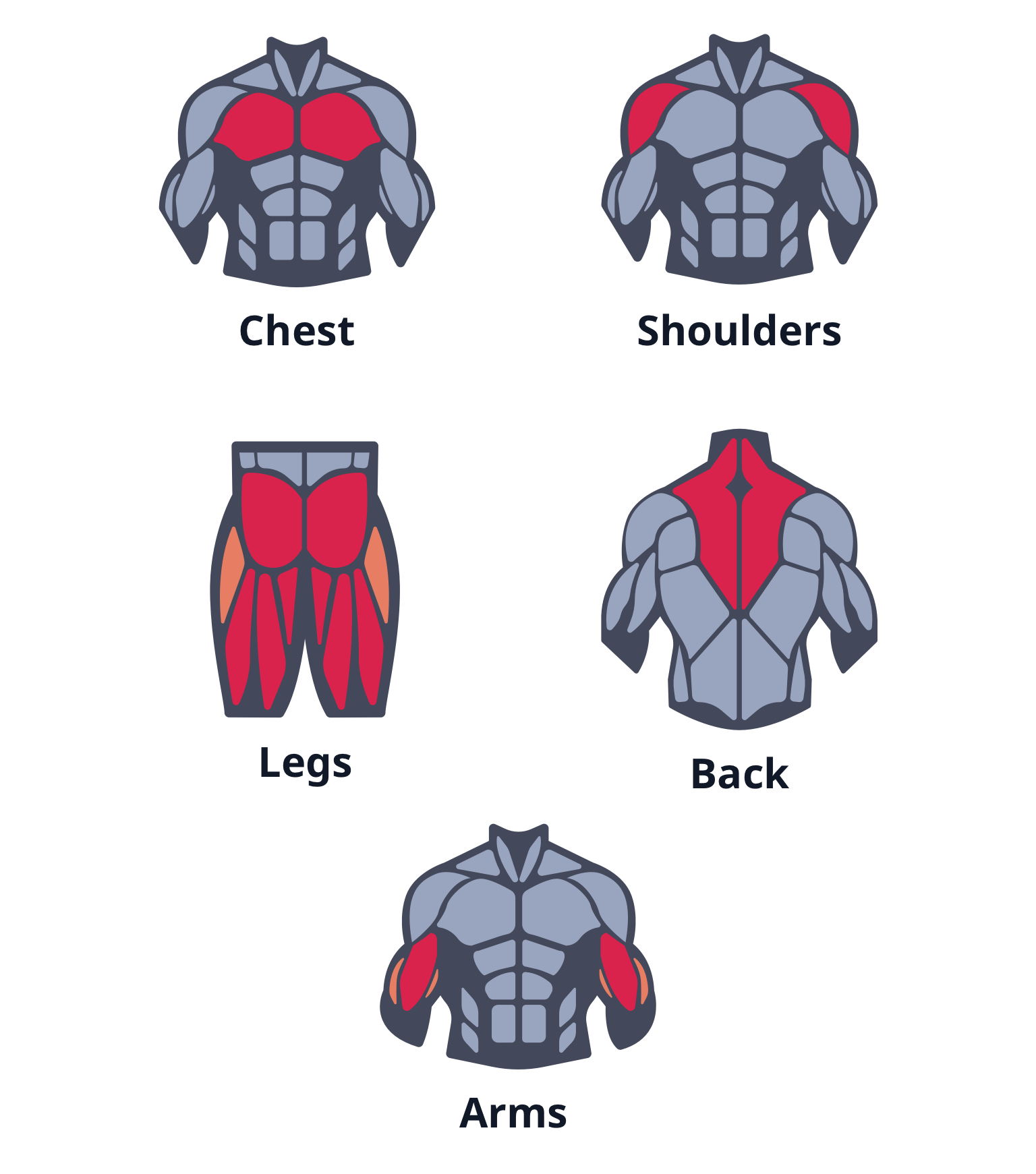The Intense Bro Split – 5 Day Workout Routine
If you’ve trained with the bro split for a few months, you’re probably hitting a plateau right about now. You could of course move up to a push pull legs, but perhaps you want to progress with the bro split a little further? This routine really dials the INTENSITY up to 11! You were warned 🔥
Definitely not suitable for beginners • 5 days per week

via Gumroad.com - Download this workout plan without ads, for free by entering $0 or name a fair price.
If you train more than 3 days per week, you’ll be following a split workout routine of some kind, rather than a full body routine. Many bodybuilders get started with a 5 day bro split routine, where you dedicate each day of the week to a specific muscle group.
One downside of the bro split is that you only work each muscle group once per week. Eventually, after training with bro split for a while, you will hit a plateau where you struggle to make progress. Many people say you should follow a bro split for a maximum of 12 weeks.
While many graduate onto a PPL, ULPPL or PHAT to maximize their training frequency, you might prefer to follow a bro split out of familiarity, habit or preference. But there is a way to extend the mileage of the bro split, and it’s really simple… just turn up the intensity!
Gym Geek’s high-intensity bro split has 6-8 exercises in each workout. It’s a 5 day per week program that maxes out on intensity, making it a high-volume strength training routine.
Reasons to like the bro split
In general, there a 4 different styles of workout routine you can train with:
- Full-body workout – Full body workouts hit every major muscle group in a single session. Due to required rest days, this is best followed 1-3 days per week.
- Bro split – In a bro split, you work each muscle group once per week. Each day of your split is dedicated to a specific muscle group, providing a large amount of recovery time between exercises.
- Upper/lower split – Upper/lower routines split workouts between upper body and lower body exercises, alternating on each day of your routine.
- Push/pull/legs (PPL) split – A PPL routine splits your workout days into push days and pull days, with an extra day dedicated solely to your leg exercises.
Bro split vs full body workouts
Full body workout routines work well if you are training casually or you are severely limited on time. If you train 2 days per week, it could be a good option.
The main disadvantage of full body routines is that they limit your intensity. Because you are working all your major muscle groups in a single session, it’s difficult to maintain a high intensity for any one part of your body.
You could overcome this by training more frequently, but full body workouts limit you here too. Because you need 48 hours of rest and recovery time between training the same muscle, you can’t follow a full body routine more than 3 days per week!
Bro splits overcome both these limitations. First, you can hit a higher intensity in each workout session because you are focusing on one muscle group at a time.
And second, because you are only working each muscle once per week, you can train with a bro split 5 days per week.
Bro split vs push pull legs (PPL)
Push pull legs (PPL) routines split your workouts into three categories: push exercises (chest, shoulders and triceps), pull exercises (back, biceps and rear delts) and leg exercises.
PPL is different in this way because you are working multiple muscle groups in each workout. This is actually an advantage over the bro split, because you complete the full routine in 3 days, by which time you’re first workout (pull day) will be fully rested and ready to go again…
That means you can workout with a PPL up to 6 times per week.
Some people prefer the bro split because it does allow for more targeted and specific workouts. Because you are focusing on one muscle group at time, you have more control over your routine and can easily adjust the intensity up and down.
Planning your bro split
The bro split divides your week into 5 days. One each day, you focus on training one muscle group. In the high-intensity bro split, the aim is to exhaust each muscle group fully on its workout day, which will promote maximal muscle growth and strength gains.
A typical bro split might look something like this:
- Monday – Chest
- Tuesday – Shoulders
- Wednesday – Legs
- Thursday – Back
- Friday – Arms

The most important part of planning your bro split is choosing the exercises you will perform on each day of the routine. The aim is to avoid conflicting exercises on consecutive days of the week. For example, if you are targeting chest on Monday, you should ensure that Tuesday’s exercises avoid chest muscle groups.
The 5 Day Bro Split Workout Routine
Monday – Chest day
- Bench press – 4 sets of 8-10 reps
- Incline dumbbell press – 4 sets of 8-10 reps
- Incline dumbbell fly – 4 sets of 12 reps
- Cable crossovers – 3 sets of 15 reps
- Decline hammer strength machine or Decline press – 3 sets of 12 reps
- Pec deck – 3 sets of 15 reps
- Push-ups – 3 sets of 15-20 reps
Tuesday – Shoulder day
- Standing military barbell press – 4 sets of 8-10 reps
- Dumbbell lateral raises – 4 sets of 12-15 reps
- Seated dumbbell shoulder press – 4 sets of 10-12 reps
- Dumbbell front raises – 4 sets of 8-10 reps per arm
- Rear delt flyes – 4 sets of 12-15 reps
- EZ bar upright rows – 4 sets of 10-12 reps
- Dumbbell shrugs – 3 sets of 15 reps
Wednesday – Leg day
- Barbell squats – 4 sets of 8-10 reps
- Leg press machine – 4 sets of 10-12 reps
- Hack squat machine – 4 sets of 10 reps
- Leg extensions – 3 sets of 15 reps
- Hamstring curls – 3 sets of 15 reps
- Standing calf raises – 3 sets of 20 reps
Thursday – Back day
- Barbell bent over rows – 4 sets of 8-10 reps
- Wide grip pull ups – 4 sets of 10 reps
- Close grip lat pulldown machine – 4 sets of 12 reps
- T-bar rows – 4 sets of 8-10 reps
- Dumbbell rows – 3 sets of 10 reps per arm
- Hyperextensions – 3 sets of 15 reps
- Reverse grip pulldowns – 3 sets of 15 reps
Friday – Arms day
- EZ bar curls – 4 sets of 12-15 reps
- Seated double arm dumbbell curls – 4 sets of 10 reps
- Standing hammer curls – 4 sets of 10-12 reps
- Preacher curl machine – 3 sets of 10-12 reps
- Triceps rope pushdowns – 4 sets of 15-20 reps
- Triceps overhead extensions – 4 sets of 15 reps
- Skull crushers – 3 sets of 12-15 reps
- Close grip smith machine bench press – 3 sets of 15 reps
Saturday & Sunday – Rest days

Tips
Gradually increase the intensity
Compared to most bro splits, this one is high intensity! There’s a large number of exercises on each day, with a large total number of sets.
Rather than rapidly increasing the intensity of your workout, consider reducing the intensity by doing fewer sets per session.
Progressive overload
Progressive overload is the method of increasing volume, intensity or frequency of an exercise. This increase puts greater challenge to your muscles and pushes your to its comfortable limits, which is an important part of progressing through strength and muscle gain workouts.
In the 5 day workout split, progressive overload happens when you increase weight or target reps of your workouts. You should aim to increase the difficulty of your workouts slowly over time for the best muscle strength and endurance outcomes.
Cardio
Consider the best type of cardio to incorporate into your weekly workout routine. We recommend you do some cardio at least 3 days per week. Cardio can include running (including treadmill), jogging and cycling, for example.
If your goal is weight loss, you should increase the amount of cardio you do each week. Cardio is great for weight loss because it burns calories. On the other hand, if you goal is building muscle, you should put greater emphasis on the strength and weight training exercises of the 5 day plan.
When to do cardio exercises is a personal preference. Some people prefer to do cardio in the morning, whereas others may prefer to do it after their weight training workouts. Since everyone is different, it’s important to find out what works best for you. It’s important to remember to leave adequate rest time between your workouts.
You might also consider some low-impact cardio activities. This can be an effective way to burn fat, while reducing the risk of joint or muscle injury.
Reps in reserve
Training to failure can maximize muscle growth, but it comes with risks that you should not ignore. The biggest risk is overtraining or injury. If you do train to failure, you should do so occasionally and not routinely during a 5 day workout split plan.
An alternative idea is that of “reps in reserve”. This measures the intensity of a set by calculating the number of reps left when a set ends. For example, if an exercise has 8 reps and you complete 6, the reps in reserve is 2.
Reps in reserve is a useful way to decide when to add or remove volume from your workout. If you consistently have 0 or 1 reps in reserve, you may want to consider increasing the volume of your workouts. It’s important to push yourself, but you should make any changes gradually and not risk injury.
